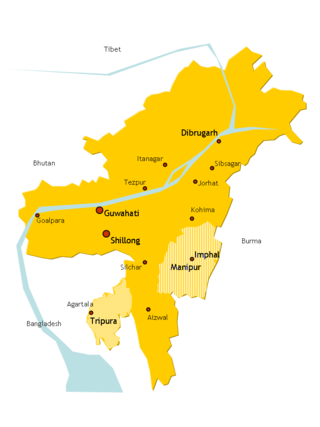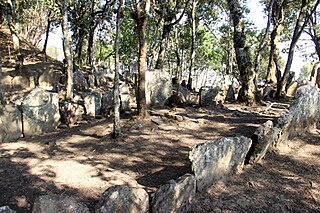
Mizo Hlakungpui Mual (Mizo Poets' Square) is a monument to commemorate Mizo poets. [1] It was set up in 1986 [2] at the southern edge of Khawbung Village, Mizoram state, North-East India, about 100 miles northwest of Chittagong, Bangladesh.

Mizo Hlakungpui Mual (Mizo Poets' Square) is a monument to commemorate Mizo poets. [1] It was set up in 1986 [2] at the southern edge of Khawbung Village, Mizoram state, North-East India, about 100 miles northwest of Chittagong, Bangladesh.
In time, the local people decided to include all the Mizo Poets and writers who deserved recognition for their contributions to Mizo literature. The Committee agreed, and the selection procedures go as – Writers who have produced at least 3–4 books, and have had a prolonged influence on Mizo literature would be selected while Poets whose songs/poems have exceptional literary value would also be included. Writers/poets may only be included in Hlakungpui Mual five years after their death. [1]
In the first phase were erected the monuments of Patea and Damhauhva on 6 & 7 April 1986 with their skeletal remains taken from their old grave, then were buried in the ground beneath their pyramidal monument. They were the first two interred in the Poets' Square.
Patea composed 55 poems whose lyrics and harmonies expressed deeply traditional Mizo sentiments. His lyrics are mainly about lamentation, praise and heavenly sentiments. [3]
Damhauhva wrote 51 poems highly prized for their literary qualities in Mizo poetry. His poetical words emphasizing natural beauties and its harmonies are well matched. He composed many fine poems. The values of human life with regards to nature are expressed with poetical words. [4]
In course of time, there was an attempt to commemorate famous poets and writers whose fame spread throughout Mizoram and its adjoining regions. The process of selecting poets and writers was also strictly carried out. They had, to some extent, imitated what were found in Poets' Corner, the name traditionally given to a section of the south transept of Westminster Abbey.
Below are the poets and writers arranged in order from the pyramidal monuments of Patea and Damhauva.

Below are the names of poets and writers included in the third phase.

The Silver Jubilee of Mizo Hlakungpui Mual was celebrated on 6–7 April 2011 at the Poets' Square site in Khawbung, Mizoram, India. [5] [6]


Mizoram is a state in northeast India, with Aizawl as its seat of government and capital city. The name of the state is derived from "Mizo", the self-described name of the native inhabitants, and "Ram", which in the Mizo language means "land." Thus "Mizo-ram" means "land of the Mizos". Within India's northeast region, it is the southernmost landlocked state, sharing borders with three of the Seven Sister States, namely Tripura, Assam and Manipur. The state also shares a 722-kilometre (449 mi) border with the neighbouring countries of Bangladesh and Myanmar.
Hmar, also spelled as Mar, is an Kuki ethnic group living in Northeast Indian state of Manipur and Mizoram, western Myanmar (Burma) and eastern Bangladesh.

The Mizo people, are a Tibeto-Burmese ethnic group native to the Indian state of Mizoram and neighbouring regions of Northeast India. They are related to the Kuki people and Chin people. The term Mizo covers several related ethnic groups or clans inside the Mizo group. And before 1947, The name Kuki was used by all Zo people but after Mizoram statehood was achieved, the term Mizo gained prominence.

The history of Mizoram encompasses the history of Mizoram which lies in the remotest part of northeast India. It is a conglomerate history of several ethnic groups of Chin people who migrated from Chin State of Burma. But information of their patterns of westward migration are based on oral history and archaeological inferences, hence nothing definite can be said. The recorded history started relatively recently around the mid-19th century when the adjoining regions were occupied by the British monarchy. Following religious, political and cultural revolutions in the mid-20th century majority of the people agglomerated into a super tribe, Mizo. Hence the officially recognised settlement of the Mizos became Mizoram.

Lunglei is a town, situated in the south-central part of Mizoram state, northeastern India. Lunglei, literally meaning 'bridge of rock' got its name from a bridge like rock found in the riverine area around Nghasih - a small tributary of Tlawng the longest river in Mizoram. It is the largest town after the capital, Aizawl, located 165 km (102 miles) south of Aizawl.
The Mizo language, is a Kuki-Chin language belonging to the Tibeto-Burman language family, spoken natively by the Mizo people in the Mizoram state of India and Chin State and Sagaing Division in Myanmar. The language is also known as Duhlian and Lushai, a colonial term, as the Duhlian people were the first among the Mizos to be encountered by the British in the course of their colonial expansion. The Mizo language is mainly based on Lusei dialect but it has also derived many words from its surrounding Mizo sub-tribes and sub-clan. Now, Mizo language or Mizo ṭawng is the lingua franca of Mizoram and its surrounding areas and to a lesser extent of Myanmar and Bangladesh and in India in some parts of Assam, Tripura, Manipur, Meghalaya and Nagaland. Many poetic languages are derived from Pawi, Zomi, and Hmar, and most known ancient poems considered to be Mizo are actually in Pawi. Mizo is the official language of Mizoram, along with English, and there have been efforts to have it included in the Eighth Schedule to the Constitution of India.

Serchhip is the headquarters town of Serchhip district in the Indian state of Mizoram, and also the headquarters of Serchhip Sadar subdivision. It lies in the central part of Mizoram, and 112 km away from the State capital city of Aizawl. The district has the highest literacy all over India. The origin of the name comes from citrus trees found on top of the first hill of the then Serchhip village. The word meaning of Ser-chhip is 'citrus-on-top'. In addition to the former Serchhip village, the Town Area now included New Serchhip and Chhiahtlang villages.
Sentimental poetry is a melodramatic poetic form. It is aimed primarily at stimulating the emotions rather than at communicating experience truthfully. Bereavement is a common theme of sentimental poetry.
Nationality words link to articles with information on the nation's poetry or literature.
Nationality words link to articles with information on the nation's poetry or literature.
Nationality words link to articles with information on the nation's poetry or literature.
Vaphai is a village at the extreme east of Champhai district of Mizoram.
Mizo literature is the literature written in Mizo ṭawng, the principal language of the Mizo peoples, which has both written and oral traditions. It has undergone a considerable change in the 20th century. The language developed mainly from the Lushai language, with significant influence from Pawi language, Paite language and Hmar language, especially at the literary level. All Mizo languages such as Pawi language, Paite language etc. remained unwritten until the beginning of the twentieth century. However, there was unwritten secular literature in the form of folktales, war chants etc. passed down from one generation to another. And there was rich religious literature in the form of sacerdotal chants. These are the chants used by the two types of priests, namely Bawlpu and Sadâwt. This article is about the written literature.
Zairema was a Presbyterian minister, and a pioneer in theology and literature among the Mizo people of northeast India. He was the first Mizo to obtain the degrees of BSc and BD. He died of cardiac problem on the morning of 17 December 2008 at his residence in Aizawl at the age of 91. He is best remembered as the "father of Mizoram Synod".
Edwin Rowlands was a Welsh Christian missionary in northeast India and Burma. He was a professional teacher, singer, composer, poet, translator and literary figure among the Mizo people. He was regarded as the most beloved of all British missionaries in Mizoram. He was more popularly known as Zosapthara. He made the major hymns in Mizo and Khumi which are still in use. He modified the original Mizo alphabet and his system became the standard in Mizo language. He created written language for Khumi people in Burma, and for Bhil people in Maharashtra. His literary works are the foundation of Mizo literature. He was the first administrator of education in Mizoram as Honorary Inspector of Schools. Despite objection from various corners he married Thangkungi, a Mizo girl.

Northeast India consists of the eight states Arunachal Pradesh, Assam, Manipur, Meghalaya, Mizoram, Nagaland, Sikkim and Tripura. Tourism in this area is based around the unique Himalayan landscape and culture distinct from the rest of India.

Mizoram is a state in the northeast of India. Mizoram is considered by many as a beautiful place due to its dramatic landscape and pleasant climate. There have been many attempts to increase revenue through tourism but many potential tourists find the lack of amenities to be a hurdle. However, the State continues to promote itself and many projects have been initiated. The tourism ministry continues to maintain or upgrade its tourist lodges throughout the state. Foreign tourists are required to obtain an 'inner line permit' under the special permit before visiting. The permit can be obtained from Indian missions abroad for a limited number of days or direct from Mizoram Government authorities within India. The state is rich in bird diversity, which has the potentiality to make it a major birding destination. Mizoram is a stronghold for Mrs. Hume's pheasant. There is also a rare record of the wild water buffalo from the state. There are several past records of the Sumatran rhinoceros from Mizoram, then Lushai Hills. The small population of wild elephants can be seen in Ngengpui and Dampa Sanctuaries. Some of the interesting sites are Mizo Poets' Square also known as Mizo Hlakungpui Mual in Mizo, the Great Megaliths locally known as 'Kawtchhuah Ropui'.
Pahlira Sena Chawngthu (1922–2005) was a Mizo poet, singer, and radio broadcaster from the Indian state of Mizoram.

Laltluangliana Khiangte is a Mizo academic, playwright and poet of Mizo literature. He was the principal of the Serampore College and a former professor at Pachhunga University College and the North Eastern Hill University. He is presently serving as the senior most professor at the Department of Mizo at Mizoram University. He is a recipient of the Pu Buanga Award, the highest literary award of the Mizo Academy of Letters. The Government of India awarded him the fourth highest civilian honour of the Padma Shri, in 2006, for his contributions to Indian literature.
Egbert Martin, writing under the alias Leo, was a 19th-century Guyanese poet.